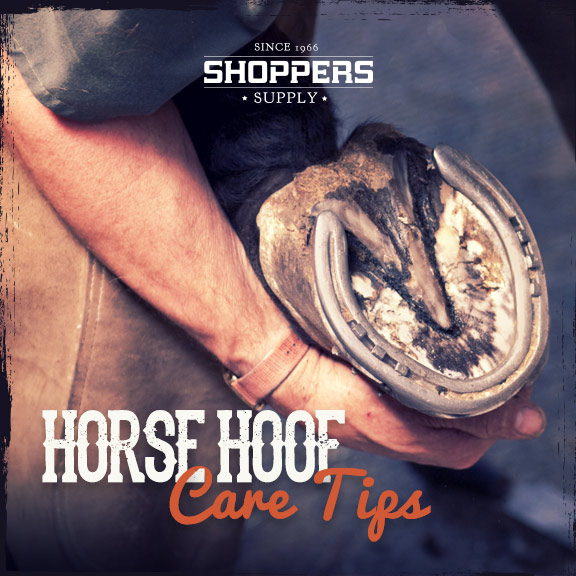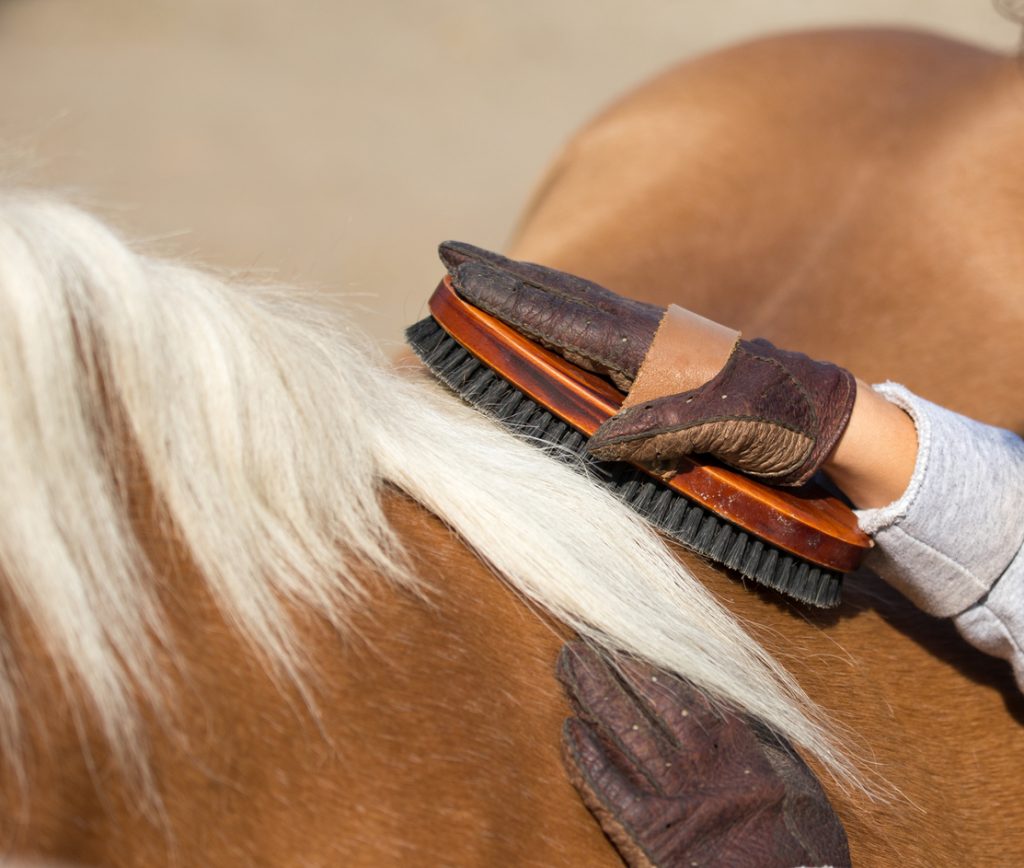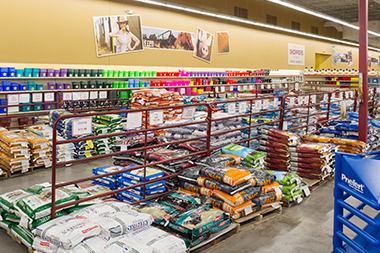Horse Hoof Care Tips

How to Keep Your Horse’s Hooves Healthy
Horse hoof care is one of the most important, yet sometimes forgotten, requirements for a healthy horse. This article will provide some basic horse hoof care tips to help you get started!
Your Friend, the Farrier
The farrier is one of the most important partners you and your horse have, besides the veterinarian. Make sure you choose a reputable, experienced one that you can trust! The farrier trims hooves, inspects shoes, and detects and corrects any problems such as under-run heels, a club foot, or flare in the hoof walls. And of course, they replace shoes if your horse has them.
Schedule routine hoof care with your farrier every six to eight weeks, depending on how fast your horse’s hooves grow. If you notice any issues, for example forging (striking the back of a front hoof with the toe of a back hoof), discuss shorter intervals between appointments with your farrier. Some horses may need care every four weeks instead of every six or eight.
One thing you should learn from the farrier is how to remove a shoe. Most farriers are glad to show you how, and your horse will be too if you need to relieve it from pain and possible hoof damage, from a sprung or shifted shoe.
Training Your Horse to Cooperate
If you haven’t picked your horse’s hooves before, or you’re a new horse owner, you may find that your horse isn’t fond of getting its feet picked up. The good news is, you can train your horse to tolerate people handling their feet pretty easily, it just takes some training! You (and your farrier) will have a much easier time working on your horse’s feet.
One way to get your horse to pick up its foot is to pinch together the two sides of the chestnut on the leg you’re trying to lift. The chestnut is the callous on the inside of each front leg, slightly above the knee, and is below the hock on the hind legs (though not all horses have one on the hind legs). When it lifts its leg, be sure to praise your horse with a pat on the shoulder, or treat, to reward them.
If that doesn’t work well, try pinching the lower tendon that runs along the back of the leg as you try to lift the foot. This activates a kind of horse “reflex”, encouraging the horse to lift the foot.
Once you’ve got the hoof in hand, you’re ready to start giving your horse a “pedicure!”
Your Job as Horse Parent: Get Picky
A hoof pick is one of the most important grooming tools you should have in your repertoire. Contrary to what many horse owners may think, picking out your horse’s hooves isn’t a farrier’s job, it’s yours! So get ready to get picky.
Here are a few tips for getting picky with your horse’s hooves:
- Use the pick to pry out any packed debris, gently clearing out all the nooks and crannies of each hoof.
- Scrape away any remaining bits of debris off the sole and use a brush (you can buy a pick that comes with one or buy the brush separately), so that you can clearly see the entire surface of the sole.
How often should you pick your horse’s hooves? Before each ride, after you untack them, when you bring them in for the night, and before turnout in the morning. Following this schedule will make cleaning the hooves a normal part of your routine, and your horse will get used to it (which will make your job easier and faster).

What to Look Out For
Taking the time to clean and inspect your horse’s hooves can help you detect any signs of infection or abscesses—which could create painful problems later on.
When picking your horse’s hooves, keep an eye out for signs of common issues such as:
Thrush: a bacterial condition caused by long periods of standing in mud, manure, or other wet conditions. You’ll notice a foul smell and dark ooze in the cleft of the frog. Caught early, thrush is simple to treat. Ask your farrier or veterinarian which over the counter remedy they recommend, and make sure the horse’s stall is clean and dry.
Puncture: this happens when a nail or other object pierces the sole, then either falls out or gets stuck. The most important thing to remember is to never try to pull an object out of the hoof. You don’t want to accidentally make the problem worse! Instead, call the vet right away so they can take an x-ray to see how deep the object has penetrated the foot, and safely remove it.
Cracks: though some cracks are superficial, some can affect sensitive hoof structures and cause a painful abscess. If you see a crack, give your farrier a call and describe the location/size of it so they can decide whether it needs immediate attention, or can wait for the next shoeing appointment.
Abscesses: if your horse’s foot is warmer than normal, or the pulse is stronger than usual (you’ll get a sense of what’s “normal” after a few sessions of hoof cleaning), it could be because of an abscess. Abscesses can be the result of a badly placed shoeing nail, a bruise, or sole puncture. Abscesses are very painful and can be obvious; the horse may be slightly lame on the problem foot.
If you notice the same issue in both front feet, and the horse is constantly shifting from foot to foot, it could be a sign of a serious condition called laminitis. Call your vet and get the condition treated promptly. Laminitis can cause severe damage to your horse’s feet, and can even be fatal!
If you don’t notice any of these conditions in your horse’s feet, great! If you do notice something, you’ve likely caught it early. Regular picking will help you find problems quickly so your horse doesn’t suffer (and prevent expensive vet bills).

Nutrition
A balanced diet keeps your horse’s entire body in good shape, including its hooves! Provide quality horse feed along with plenty of clean water. A quality feed ensures your horse gets all the vitamins and nutrients it needs to thrive.
Forage is another great source of vitamins and minerals, as well as additional moisture. The more access horses have to fresh water, the better—especially here in the desert!
Supplements
Supplementing your horse’s diet with a salt block will help it get additional minerals it needs, and give it something delicious to snack on. You may also want to discuss biotin supplements with your veterinarian. Biotin aids in hoof growth and improves weak or cracked hooves.
Next Steps
Now that you know the basic horse hoof care tips you need to give your horse a (healthy) “leg to stand on,” it’s time to put them into practice! And for aquality horse feed stores, supplements, hoof picks, and other supplies, stop by your local Shoppers Supply in Gilbert, Apache Junction or Chandler.